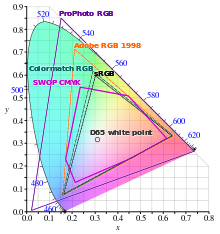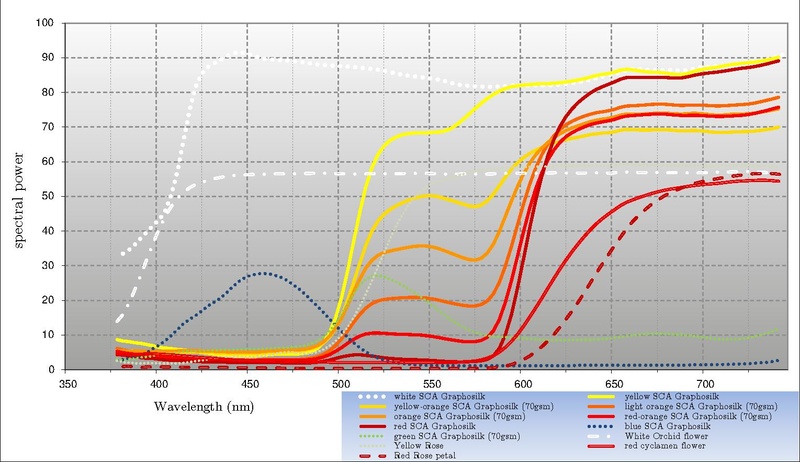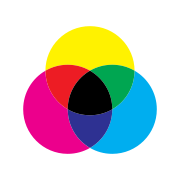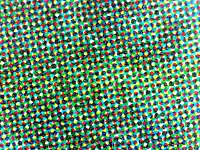CMYK color model
The CMYK color model (also known as process color, or four color) is a
The CMYK model works by partially or entirely masking colors on a lighter, usually white, background. The ink reduces the light that would otherwise be reflected. Such a model is called subtractive because inks "subtract" the colors red, green and blue from white light; white light minus red leaves cyan, white light minus green leaves magenta, and white light minus blue leaves yellow.
In
Halftoning

With CMYK printing, halftoning (also called screening) allows for less than full saturation of the primary colors; tiny dots of each primary color are printed in a pattern small enough that humans perceive a solid color.[1] Magenta printed with a 20% halftone, for example, produces a pink color, because the eye perceives the tiny magenta dots on the large white paper as lighter and less saturated than the color of pure magenta ink.[citation needed] Halftoning allows for a continuous variability of each color, which enables continuous color mixing of the primaries. Without halftoning, each primary would be binary, i.e. on/off, which only allows for the reproduction of eight colors: white, the three primaries, the three secondaries, and black.
Comparison to CMY

The CMYK color model is based on the CMY color model, which omits the black ink. However, the imperfect black generated by mixing commercially practical cyan, magenta, and yellow inks is unsatisfactory, so four-color printing uses black ink in addition to the subtractive primaries. Common reasons for using black ink include:[2]
- In traditional preparation of color separations, a red keyline on the black line art marked the outline of solid or tint color areas. In some cases a black keyline was used when it served as both a color indicator and an outline to be printed in black because usually the black plate contained the keyline. The K in CMYK represents the keyline or black plate, also sometimes called the key plate.[3]
- Text is typically printed in black and includes fine detail (such as serifs). To avoid even slight blurring when reproducing text (or other finely detailed outlines) using three inks would require impractically accurate registration.
- A combination of 100% cyan, magenta, and yellow inks soaks the paper with ink, making it slower to dry, causing bleeding, or (especially on low quality paper such as newsprint) weakening the paper so much that it tears.[citation needed]
- Although a combination of 100% cyan, magenta, and yellow inks should, in theory, completely absorb the entire visible spectrum of light and produce a perfect black, practical inks fall short of their ideal characteristics, and the result is actually a dark muddy color that does not quite appear black. Black ink absorbs more light and yields much better blacks.
- Black ink is less expensive than the combination of colored inks that makes black.
A black made with just CMY inks is sometimes called a composite black.[4]
When a very dark area is wanted, a colored or gray CMY "bedding" is applied first, then a full black layer is applied on top, making a rich, deep black; this is called rich black.[5]
The amount of black to use to replace amounts of the other inks is variable, and the choice depends on the technology, paper and ink in use. Processes called
Other printer color models
CMYK or process color printing is contrasted with spot color printing, in which specific colored inks are used to generate the colors appearing on paper. Some printing presses are capable of printing with both four-color process inks and additional spot color inks at the same time. High-quality printed materials, such as marketing brochures and books, often include photographs requiring process-color printing, other graphic effects requiring spot colors (such as metallic inks), and finishes such as varnish, which enhances the glossy appearance of the printed piece.[7]
CMYK are the process printers which often have a relatively small color
Comparison with RGB displays

Comparisons between
Similar to monitors, the inks used in printing produce a color gamut that is "only a subset of the visible spectrum" although both color modes have their own specific ranges. As a result of this, items which are displayed on a computer monitor may not completely match the look of items which are printed if opposite color modes are being combined in both mediums.[11] When designing items to be printed, designers view the colors which they are choosing on an RGB color mode (their computer screen), and it is often difficult to visualize the way in which the color will turn out post-printing because of this.
Spectrum of printed paper
To reproduce color, the CMYK color model codes for absorbing light rather than emitting it (as is assumed by RGB). The "K" component absorbs all wavelengths and is therefore achromatic. The cyan, magenta, and yellow components are used for color reproduction and they may be viewed as the inverse of RGB. Cyan absorbs red, magenta absorbs green, and yellow absorbs blue (-R,-G,-B).[12]

Conversion


Since RGB and CMYK spaces are both device-dependent spaces, there is no simple or general conversion formula that converts between them. Conversions are generally done through
ICC profiles, internally built out of lookup tables and other transformation functions, are capable of handling many effects of ink blending. One example is the dot gain, which show up as non-linear components in the color-to-density mapping. More complex interactions such as Neugebauer blending can be modelled in higher-dimension lookup tables.
The problem of computing a colorimetric estimate of the color that results from printing various combinations of ink has been addressed by many scientists.
Standardization of printing practices allow for some profiles to be predefined. One of them is the US Specifications for Web Offset Publications, which has its ICC color profile built into some software including Microsoft Office (as Agfa RSWOP.icm).[14]
See also
- CMY color model
- CcMmYK color model
- Cycolor
- RGB color model
- Grey component replacement
- Jacob Christoph Le Blon
- SWOP CMYK standard
- Color management
- Born Villain#Release and artwork
References
- ISBN 0-8194-3318-7.
- ISBN 0-8230-5857-3.
- ^ Menegus, Bryan (May 20, 2016). "The Difference Between RGB and CMYK, Explained". Gizmodo. Retrieved October 4, 2020.
- ISBN 978-1-118-89772-0.
- ISBN 0-471-36011-2.
- ISBN 3-540-67326-1.
- ^ Davies, Helen (August 3, 2020). "Top 8 Large Format Printing Tips To Achieve High-End Projects". Front Signs. Archived from the original on September 29, 2020. Retrieved October 4, 2020.
- S2CID 20555157.
- ISBN 0-672-32430-X.
- ^ "Overview of color in Illustrator". Adobe Inc. Archived from the original on February 7, 2023. Retrieved October 4, 2020.
- ^ Damien van Holten, Printinternational, "RGB Vs CMYK"
- ^ "Subtractive Color Mixing". L. R. Ingersoll Physics Museum. Retrieved October 4, 2020.
- ^ ISBN 0-8493-0900-X.
- ^ "KB933845 How to obtain and install the Microsoft Standard CMYK Profile (RSWOP.icm) in Windows Vista". Beta Archive > Microsoft KB Archive. March 15, 2007. Retrieved 1 September 2023.
The RSWOP.icm cyan-magenta-yellow-black (CMYK) color profile targets the "Specifications for Web Offset Publications" (SWOP) printing standard. This color profile is installed when you install Microsoft Office. However, by default, this color profile is not installed in Windows Vista. Therefore, you may experience unexpected results when you use certain programs that manage color.
External links
- XCmyk – A Windows software with source code for converting CMYK to RGB.
- RGB to CMYK converter – Tool for RGB to CMYK color converter online.
- Color Space Fundamentals – animated illustration of RGB vs. CMYK
- ICC profile registry, which lists some standard CMYK profiles, their paper types, and color separation limits






